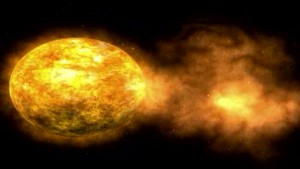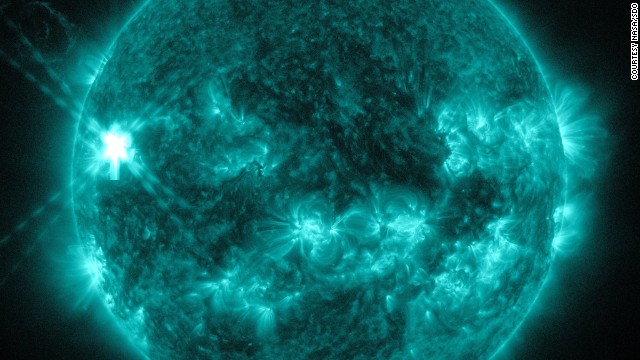Big solar storm heading toward Earth
STORY HIGHLIGHTS
- Strong geomagnetic storm watch has been issued
- Storm could impact power grid, satellites
- Auroras are possible in northern latitudes
These storms are coming
from the sun. It's raining down a huge amount of radiation. We're safe,
but it could affect power grids, radios and satellites.
Experts say the combined energy from two recent solar events will arrive at Earth on Saturday, prompting the Space Weather Prediction Center to issue a strong geomagnetic storm watch.
Wait. What kind of watch? Basically, the sun is a giant ball of gas: 92.1% hydrogen and 7.8% helium. Every now and then, it spits out a giant burst of radiation called a coronal mass ejection.

Solar storms could disrupt power, GPS
These ejections are
sometimes associated with solar flares, the most explosive events in the
solar system. The sun has released two ejections in the past two days,
and both are linked to solar flares.
The energy from those two ejections is heading toward Earth.
Space weather experts aren't sure what this solar storm will do.
"This is a pretty strong
solar storm, and we just won't know until it gets here" what it will do,
said CNN meteorologist Chad Myers.
Earth's atmosphere
usually protects us humans, but you might want to keep a flashlight
handy. Solar storms can knock out power, interfere with GPS and radio
communications -- including those on commercial airliners -- and damage
satellites.
"People on the ground
really don't have to worry," said Lika Guhathakurta, a program scientist
with NASA's Solar Dynamics Observatory. She said solar storms don't
affect humans on the ground, although astronauts could be at risk.
And our technology.
But don't worry too
much. NASA can take steps to protect the crew members on the
International Space Station, and satellite operators can turn off
sensitive sensors on satellites to mitigate the risk to your smartphones
and wi-fi connection. There may be temporary glitches, though,
Guhathakurta says.
And if there is a major issue, scientists are taking precautions to make sure all the important parties are prepared.
"FEMA has been notified
of these events just in case," Thomas Berger, director of NOAA's Space
Weather Prediction Center, said at a Thursday news conference.
On March 13, 1989, a solar storm knocked out power for the entire province of Quebec
for 12 hours. Power grids in the United States were affected but didn't
have blackouts. NASA says some satellites tumbled out of control for
hours during what's known as the Quebec Blackout. The space shuttle
Discovery was in orbit at the time and had a mysterious sensor problem
that went away after the storm, NASA says.
On the upside, solar
storms also create beautiful aurora. Aurora watchers in the northern
United States who are outside major metropolitan areas should be
watching the skies on Thursday and Friday nights.
People in the southern
part of the nation are less likely to get the kind of splendid aurora
sights that people in the Northeast and Alaska will see, but it might
not hurt for them to take a glance at the sky anyway, just in case.
Although it won't be as
intense a view as the one northerners will get, "if you want to take a
look on Friday night, why not?" Berger said.
From Around the Web
-
Not Having One Of These Credit Cards in 2014 May Be a Huge Mistake NextAdvisor Daily
-
Better Off Without Them: 10 Cars Not Worth Ever Leaving the Lot Business Cheat Sheet
-
Do You Know What Your Last Name Means? Ancestry.com
-
Gmail is....OUT! Check out the latest email tool. The Dodger Blog

No comments:
Post a Comment
Please leave a comment-- or suggestions, particularly of topics and places you'd like to see covered